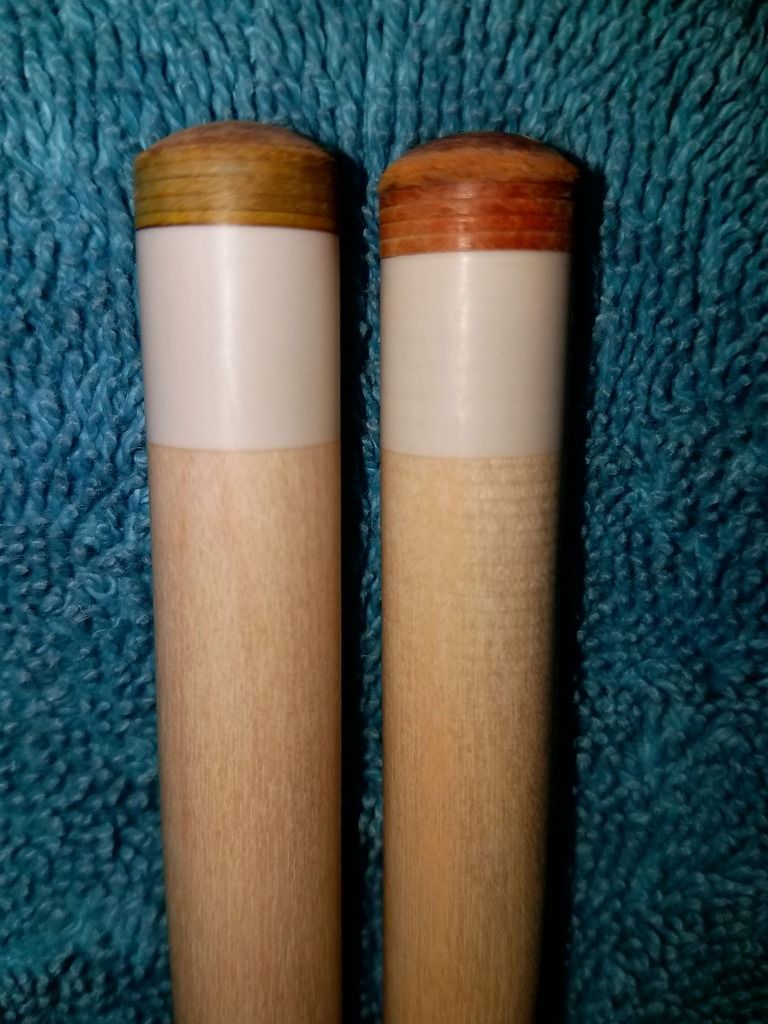I bought a foot of this material to try on different cues. Note that I am not an exprerienced cue maker and I cannot go too deep in comparision to other materials as I havent worked with many in cue making. Machining plastics is something that I am really familiar with though as I work as a CNC machinist and used to work in a place where I would machine all kinds of different plastics in to bushings, seals, jigs and everything one can imagine. So I know what to look for in a material when cutting it.
Here are my thoughts on it

The Tomahawk material is very deep in colour. It feels very stiff in your hands and is a bit darker in colour in the rod form. It lightens quite a lot when polished to a shine.
It cuts exactly as in mr. Dzurickys videos, with ribbons when turning and it heats up easily with dull cutting bits. As with all plastic materials, sharp tools and patience are required when working on. With a decent lathe and sharp tools it is rather easy to cut and doesnt need any special thought. From a machinists point of view I approve the cutting properties :thumbup:
I changed the ferrules of a Players HXT shaft and later a Predator 314'2 shaft. For the HXT I had to make tiny grooves on the tenon as it's LD properties are achieved by using some sort of light and very fragile wood in the tenon.
Below are some pictures on work in progress along with the finished products.
Old ferrule cut off the HXT, note the amount of glue residue on the tenon
Tenon cleaned and shallow grooves cut for the glue
New Tomahawk ferrule ready to install
Left to dry overnight
Cut to size, polished and G2 hard installed
For the HXT shaft I used the same tip that was on it before the ferrule change to be able to do some real comparasion of just the ferrule. From the very first hit it was evident that the ferrule job was an improvement over the standard ferrule on it. The feel of the shaft is much better, it feels a lot like a Mezz with this new ferrule like my brother described it when he played a rack with it after the change. An other note is the energy transfer, the shaft really came to life after getting a new ferrule on it. I can use less force to get the same action as before. I really like this setup a lot, it just works well together. And the ferrule stays clean very well, any chalk can be wiped off without leaving any blue on it.
I wonder how much of this caused by the poor fitment of the standard ferrule... There was a lot of epoxy on the tenon as the original ferrule was oversized to the tenon

As I liked the material a lot in the HXT, I then proceeded to do the same on my 314'2.
The reason I changed this ferrule was the fact that the original ferrule turns blue from chalk all the time and the shaft had developed a numb feeling hit for whatever reason

I was confused a bit when I cut off the old ferrule on this shaft as I expected to find a tenon with 2 different diameters as is seen on kendocues repair article, but there was nothing such to be found on my shaft. And I went slowly, under 0.1mm at a time to be sure I didnt damage the tenon that is really thin.


Left to dry. Note the LePro tip there, I put it there to make sure I dont accidentally glue the shaft to my lathe :thumbup: It was easy to remove even though some epoxy from the glue relief hole stuck to it. I guess it did its job then.

Cut to size. Note the glue relief hole on the face. I drilled a 1mm hole on the ferrule to let the air out when glueing on the new ferrule. It filled up with epoxy so it doenst leave any defects on the face when the glue is set.

The finished shaft. The tip is a Zan Hybrid Max.
The difference in feel compared to what it used to be is substantial. A lot more feedback comes from the hit and it feels a bit harder when struck. Some similarities can be found to the hit of 1st gen 314's now, it has the same snap on hit now. I initually felt that I may need a grade softer tip with it but for now I have gotten used to it already. As the sound is pleasant with the Hybrid Max and it plays fantastically well, I am going to give it a few weeks now.
I must say that it was definitely worth the effort changing the ferrule on this shaft too. As predators are notorious for the lack of feel, I feel (no pun intended) that a harder ferrule brings some back to it. Deflection is something that I was worried about before starting this project but to my pleasant surprise there was no discriminable difference between the two materials in my opinion. If there is a difference there I feel that any deflection gained is made up by the nicer acoustic characterics and the lack of chalk absorption of the Tomahawk ferrule.
Thank you j2pac for supplying me with the material.





